 |
 |
Rose clarifies the Foucauldian term "institutional technologies" as meaning the "practical techniques used to practise [the] power/knowledge" that constitute institutions (2006, 174-175). In addition to the power structures and composed visualities already discussed, most caves including Carlsbad Caverns and the Caverns of Sonora, utilize multiple additional technologies to subjectify the tourist. Some techniques produce a more generalized 'tourist' position, while some specifically interpellate the artist, the explorer or the scientist by engaging elements of these key themes.
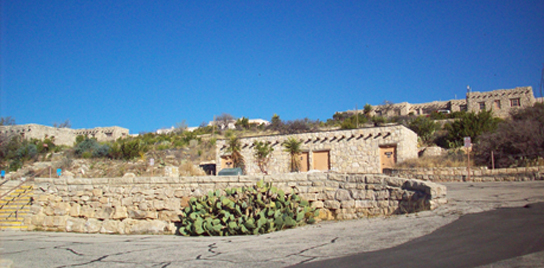 | 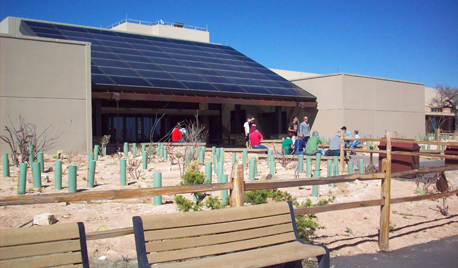 |
| All caves, like most other tourist sites, position themselves geographically and historically as well as communally. This positioning may take the form of nationalizing, as in the case of public parklands or heritage sites, or it may be more localized. Carlsbad Caverns identifies itself in the heart of the Chihuahuan desert, not just by its narratives, but also through a focus on native landscaping and locally representative art and architecture. The park chose to keep in place original stone buildings, some built by the Civilian Conservation Corps as early as the late 1930's to house park offices and non-visitor related services, a move partially made to retain the authentically natural feel of the grounds. The Visitor's Center, remodeled in the last decade, is currently revamping their landscaping to incorporate more self-sustaining, authentically native plants. Even from inside this modern building, the landscape helps to secure in the visitor a reminder that the Chihuahan desert is only steps away, and of the intrinsic value in the preservation of its natural flora and fauna. The Caverns of Sonora visually ensconce their Texas heritage in the flagstones that line the walkway to the visitors center, and utilizes Texan and more generally, frontier-style decor to carry the theme. Many show caves create displays of antiquated objects suggestive of the cave's origins, and some make use of thematic decor to emphasize the cave's historical past--even if, as in the case of the Caverns of Sonora, the "artifacts" seem contrived and superfluous to the tourist. Spaces outside the cave itself are often decorated in manners, however incongruous, that keep the visitor from forgetting where they are. |
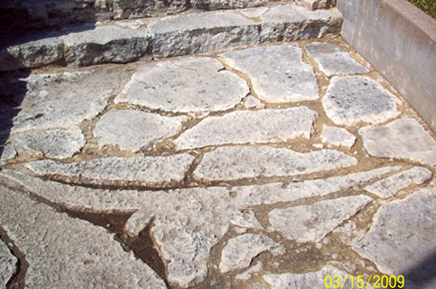 | 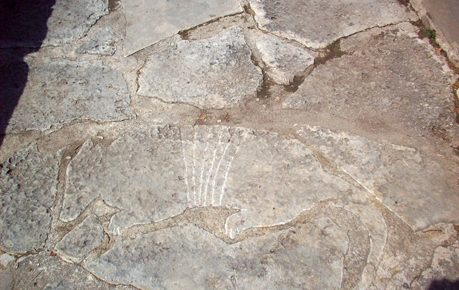 |
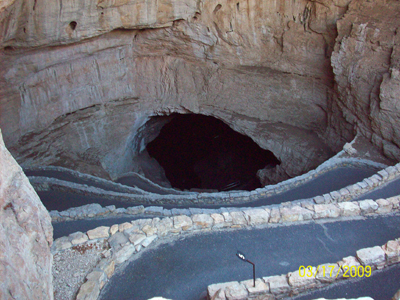 Free flowing and guided trails are marked so that the
visitor knows where they may--and are expected--to go and off-trail
spaces are barricaded to prevent confusion and self-discovery, or are
only accessible with an approved guide in tow. Along the trails,
visitors may encounter signage, park rangers or guides, and other
tourists, all of whom may explicitly or implicitly provide further
confirmation of expected behaviors and protocols while touring the cave.
Lights are turned off by guides upon leaving an area of interest to move
the tourist to the next photo opportunity and to prevent backflow.
Formations are lit by concealed or camouflaged lighting systems like the
one pictured here, encased in broken formation pieces, in order to
educate the tourist about which visualities are most important, most
beautiful or most incredible, while attempting to keep the technology as
invisible as possible. Displays, visual and audio aids supplement tour
guide narratives to specify the knowledges of science, history and art
that the cave visitor will need to properly interpret their caving
experience, and all help to establish evidentiary proof of the
Free flowing and guided trails are marked so that the
visitor knows where they may--and are expected--to go and off-trail
spaces are barricaded to prevent confusion and self-discovery, or are
only accessible with an approved guide in tow. Along the trails,
visitors may encounter signage, park rangers or guides, and other
tourists, all of whom may explicitly or implicitly provide further
confirmation of expected behaviors and protocols while touring the cave.
Lights are turned off by guides upon leaving an area of interest to move
the tourist to the next photo opportunity and to prevent backflow.
Formations are lit by concealed or camouflaged lighting systems like the
one pictured here, encased in broken formation pieces, in order to
educate the tourist about which visualities are most important, most
beautiful or most incredible, while attempting to keep the technology as
invisible as possible. Displays, visual and audio aids supplement tour
guide narratives to specify the knowledges of science, history and art
that the cave visitor will need to properly interpret their caving
experience, and all help to establish evidentiary proof of the 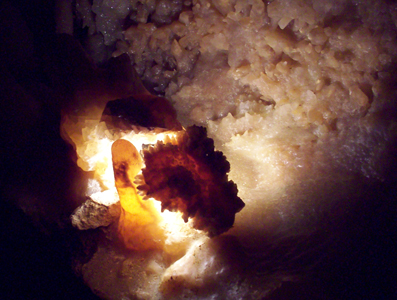 importance and
integrity of these knowledges. Signs, placards and other markers specify
both what the visitor should see, and suggest how they should see it by
providing salient historical facts, explanations of science and
exhortations to be ecologically and environmentally mindful. All along
the tour, visitors are schooled in how to see and intrerpret the
cave.
importance and
integrity of these knowledges. Signs, placards and other markers specify
both what the visitor should see, and suggest how they should see it by
providing salient historical facts, explanations of science and
exhortations to be ecologically and environmentally mindful. All along
the tour, visitors are schooled in how to see and intrerpret the
cave.
For a more detailed analysis of how technologies and apparatuses work in conjuntction to create subjectivies using Carlsbad Caverns as the primary case study, please click to pick up the complimentary pamphlet "Down the Dark Hole: Toward an Environmentally-Minded Subjectivity in Carlsbad Caverns."
Even books, souvenirs and general decor serve as supplements and reinforcements to these discursives, although they may be decidedly 'unauthentic.' "The typical cave shop sells local handicrafts and products, textiles, minerals and all sorts of stones ... The available stones are almost never from the site itself or even of local origin. They are imported from other countries or continents. Visitors are not necessarily informed about this fact" (Diekmann, et al. 2006, 279). Nevertheless, the stones are often accompanied by displays which identify the stones and outline the scientific properties and values of each, even if they may never be found at the particular cave site in question. Activities such as sluicing or gold panning are among the most common additional offerings of show caves, and are typified as interactive educational opportunities. They serve the important secondary purspose of imparting a sense of historical realism to the experience, albeit in large part imaginary. As a whole, all of these technologies are designed to shape subjectivites, enforce conformance, and contribute to the expansion of the caves' key discourses.
| Photo Artist Tour | Discovery Explorer Tour | Enviroscientist Tour |
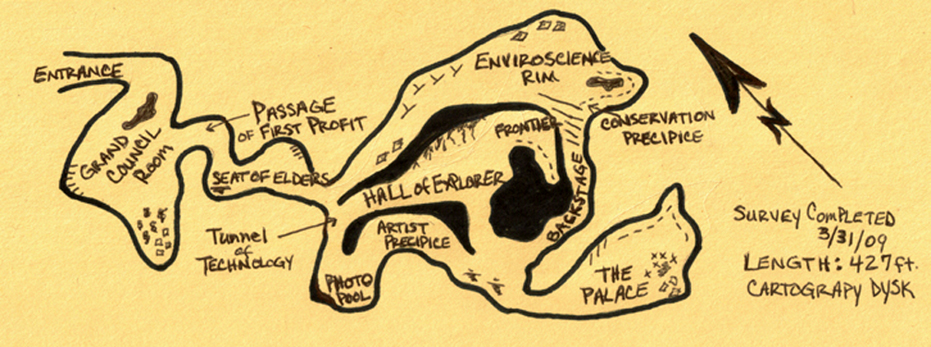 |